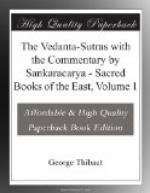entities, viz. II, 4, 10, ’What is
here the same is there; and what is there the same
is here. He who sees any difference here goes
from death to death.’—The following
circumstance, too, is worthy of consideration.
When Na/k/iketas has asked the question relating to
the existence or non-existence of the soul after death,
Yama tries to induce him to choose another boon, tempting
him with the offer of various objects of desire.
But Na/k/iketas remains firm. Thereupon Death,
dwelling on the distinction of the Good and the Pleasant,
and the distinction of wisdom and ignorance, praises
Na/k/iketas, ’I believe Na/k/iketas to be one
who desires knowledge, for even many pleasures did
not tear thee away’ (I, 2, 4); and later on
praises the question asked by Na/k/iketas, ’The
wise who, by means of meditation on his Self, recognises
the Ancient who is difficult to be seen, who has entered
into the dark, who is hidden in the cave, who dwells
in the abyss, as God, he indeed leaves joy and sorrow
far behind’ (I, 2, 12). Now all this means
to intimate that the individual Self and the highest
Self are non-different. For if Na/k/iketas set
aside the question, by asking which he had earned for
himself the praise of Yama, and after having received
that praise asked a new question, all that praise
would have been bestowed on him unduly. Hence
it follows that the question implied in I, 2, 14, ’That
which thou seest as neither this nor that,’
merely resumes the topic to which the question in
I, 1, 20 had referred.—Nor is there any
basis to the objection that the two questions differ
in form. The second question, in reality, is
concerned with the same distinction as the first.
The first enquires about the existence of the soul
apart from the body, &c.; the second refers to the
circumstance of that soul not being subject to sa/m/sara.
For as long as Nescience remains, so long the soul
is affected with definite attributes, &c.; but as
soon as Nescience comes to an end, the soul is one
with the highest Self, as is taught by such scriptural
texts as ‘Thou art that.’ But whether
Nescience be active or inactive, no difference is
made thereby in the thing itself (viz. the soul).
A man may, in the dark, mistake a piece of rope lying
on the ground for a snake, and run away from it, frightened
and trembling; thereon another man may tell him, ’Do
not be afraid, it is only a rope, not a snake;’
and he may then dismiss the fear caused by the imagined
snake, and stop running. But all the while the
presence and subsequent absence of his erroneous notion,
as to the rope being a snake, make no difference whatever
in the rope itself. Exactly analogous is the case
of the individual soul which is in reality one with
the highest soul, although Nescience makes it appear
different. Hence the reply contained in the passage,
‘It is not born, it dies not,’ is also
to be considered as furnishing an answer to the question
asked in I, 1, 20.—The Sutra is to be understood
with reference to the distinction of the individual




